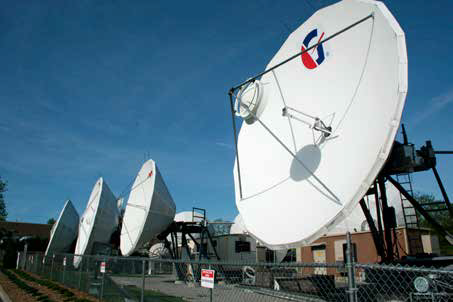The first known use of hydrocarbons dates back 6,000 years to an oil seep on the banks of the Euphrates River in what is now Iraq.

The oil bubbled up to ground level, evaporated and left behind asphalt, which people used as mortar between building stones. Over the next few thousand years, Babylonians and Mesopotamians put it to the same use. The pyramids of Egypt were held together with it. It was not until about 2,000 years ago, we think, that the Chinese began using oil and natural gas for heat and light, bringing it into their homes through bamboo pipes.
Two thousand years later, the world depends on fossil fuels to meet 82 percent of its energy needs. We use oil, gas and coal to heat and cool our homes, cook our meals and move our vehicles. Renewable energy is on a major growth track; in 2016, renewables accounted for 55 percent of all new electricity generation capacity and almost 17 percent of global power capacity, up from 15 percent the previous year.1 However, experts still predict that fossil fuels will be meeting 75 percent of world energy needs in 2035.2
The world’s emerging economies are the reason why. In developed nations, demand is largely flat, except for transportation. But emerging economies are growing fast, lifting billions out of poverty, and the rise of their middle classes is powered by fossil fuels. There is no end in sight to the quest for the Earth’s hydrocarbon wealth.
If our dependence on fossil fuels changes slowly, the technologies for finding it, recovering it and transporting it change fast. Most of that technology innovation — from horizontal precision drilling to analytics based on real-time monitoring — rests on a foundation of digital communications. In an energy industry undergoing seismic changes, the value of that digital foundation grows by the month.
Challenge, Change and Opportunity
For all its vast wealth and global reach, the petrochemical sector faces a set of converging challenges today. Lower oil prices have become the new normal and oil and gas companies are feeling the heat. Plunging prices increase the pressure to reduce costs and increase productivity. Meanwhile, environmental, safety and security pressures are pushing in the opposite direction, and the turbulent state of international politics adds to the challenges of exploring and producing.
And, if that were not enough, the availability of skilled personnel is reaching new lows. Having laid off nearly 300,000 workers worldwide at the beginning of the oil price declines in 2014, the industry is now facing the retirement of the Boomer generation. In the U.S. alone, the industry needs to hire 100,000 new workers for jobs with uncertain prospects that require long periods away from home.3
The industry has talked for years about the “digital oilfield” — shorthand for bringing the Big Data revolution to the exploration, production and transport of oil and natural gas. While progress has been made, these converging challenges are providing fresh motivation to turn that concept into an every day reality.
Substantial investment has gone into data technology over the past decade. In shale gas extraction, data from seismic monitoring helps producers adapt their drilling and fracking processes based on a better understanding of the structure of shale basins. Sensors deep in drilling equipment or producing wells send a stream of information that tells producers how equipment is performing. Sensors in pipelines measure stresses and allow operators to perform preventative maintenance or shutdowns.
In fact, the industry is nearly drowning in the output of such data, and the next big opportunity is to make sense of it all through sophisticated analytics. The goal is to capture and analyze data from all parts of the oil and gas value chain and analyze it in real-time to optimize performance. There is another goal as well: to address the talent shortage by making scarce expertise in exploration and production
go further.
The upstream divisions of oil super majors each currently spend $1-3 billion per year on acquiring data. Investments in the digital oilfield are projected to surpass US$30.7 billion per year by 2020.

Big Communications for Big Data
Data gains value when it moves. The Big Data revolution rests on a foundation of communications, and the realities of oil and gas exploration, production and transport mean that satellite plays a major role. For production rigs moored conveniently close to coastlines, it can make economic sense to run fiber-optic cable under the water, because that rig is likely to be in place for years. Point-to-point microwave is also suitable for rigs located within line of sight of each other and the land. But in deepwater, as well as the kind of remote land where most petrochemicals are found, only satellite can move the digital bits.
The communications requirements have a very wide range in terms of bandwidth and cost. At one end of the rate are pipeline networks, which typically transmit data from pressure, temperature and vibration sensors using traditional and inexpensive SCADA technology at very low bandwidth measured in kilobits per second. Because the sensors are polled by the network rather than reporting continuously, a few megabits per second of bandwidth can serve a large number of sensor locations.
At the other end of the range is real-time remote monitoring and operation of down-hole drilling, which requires a continuous stream of data and video in both directions. When remotely monitored and operated systems are at work, the bandwidth required can climb into dozens or hundreds of megabits per second.
Despite the challenges of low prices, oil and gas companies continue to invest substantially in data technology and communications to optimize their operations. Frost & Sullivan estimates that the offshore oil and gas communications market spend will exceed $460 million per year by 2020, up 28 percent since 2014, when oil prices first began to plunge.4 What are companies doing with that money?
Asset Tracking
Exploration, production and transport require a large number of high-value movable assets on land and offshore. Many of them carry volatile, potentially explosive petroleum products. Those facts have made oil and gas companies major users of satellite asset tracking technology, which uses thin-route data and GPS coordinates to map asset locations.
Shell is one company that has deployed a tracking and asset management system based on the Globalstar satellite data network. After deploying 250 tracking devices, it achieved a positive return on investment in just three months.
Petrochemical producer SABIC used a Globalstar-based solution to ensure that its 500 rail tank cars, many filled with explosive chemicals, move through its European supply chain safely and on schedule.5
Even relatively fixed assets benefit from big data. Remote surveillance of drilling and production platforms no longer requires continuous monitoring of video screens, either onboard or remotely. Instead, a local network of proximity detectors can monitor movement and build a profile of normal traffic patterns. When movement is detected where it should be taking place, the system can activate a camera to provide visual inspection. The business case for centralizing this surveillance is strong, because a single small team can remotely monitor multiple installations.
Preventative Maintenance
As companies use sensors and communications to monitor temperature, pressure and flow data, they can do much more than gain minute-to-minute status updates. As they amass data over time, it creates the opportunity to correlate the information with maintenance and shutdown experience. Big data analytics can then move from monitoring to prediction to reduce downtime and make maintenance more effective and less expensive. A leading compressor manufacturer developed customer sensor models and used predictive analytic software to actively monitor the readings from these sensors and schedule preventative maintenance for its midstream customers.6
There are 2.9 million kilometers of pipeline in just the ten countries with the biggest networks. By 2022, there are expected to be 90,000 sensors in pipelines and another 200,000 in electricity grids around the world.7
Crew Welfare
Life at the wellhead can be tough. Isolation, long-hours and dangerous work take their toll on workers and their families. Connectivity, however, makes a massive difference, whether it is email and social media or sports and entertainment streamed from the internet. They are not big data applications, strictly speaking, but are a high-value addition to the digital toolkit.
Accidents or illness impose a big burden not only on workers but on their employers, too. Transporting a sick crew member just 50 miles by helicopter for medical care can cost up to $10,000. A boat ride from the Gulf of Thailand and emergency jet to Singapore can cost up to $150,000. Remote medical systems let medics at the wellhead collect health data and share it with faraway doctors, who can diagnose, prescribe care and make the decision to evacuate if needed. According to one firm, InPlace Medical, telemedicine lets teams resolve 80-85 percent of situations quickly without the need for transport, which delivers better care as well as saving money.8
Remote Analytics
Better analytics can improve the way companies manage the entire process of drilling and connecting a well, which reduces lag time and minimizes the number of wells being drilled at the same time. Transmitting microseismic 3D images over high-bandwidth connections, for example, can substantially improve new well delivery and optimize reservoir, well and facility performance.
Down-hole multiphase sensors and measurement-while-drilling applications send a constant stream of information that, effectively analyzed, improves calibration and visualization capabilities to reduce risk and increase success rates.9
Integrated Operations
Today’s energy companies need the talents of engineers, geologists and data analysts in more corners of the world than ever before. But that demand far outstrips the supply. Big data and communications let experts work on multiple sites at the same time without ever leaving home. Making it work requires a complex array of sensors, real-time analytics to interpret the data, high-quality video, and remotely controlled equipment, from valves and motors to remotely operated submersibles. By spreading the talents of their best people around the globe, energy companies can run more of their operations at peak performance and reduce their risks.
One UK-based oilfield services company created a network that connected all of the client’s offshore rigs to a single global service center. The company estimated that centralizing support for the rigs reduced overall costs by 30 percent.10
Higher Throughput at Lower Cost
One barrier to the digital oilfield has been the cost of communications via satellite. Until recently, satellite operators have successfully defended a business model that limited capacity in order to maintain premium prices. That tended to limit the spread of applications requiring high throughput to the biggest companies and projects.
The introduction of High Throughput Satellite (HTS) systems in 2004, and their rapid acceleration beginning in 2010, is changing that dynamic. They use narrow spot beams to deliver more bandwidth at much lower cost-per-bit, which offers much more attractive economics. Rather than committing to a lump of capacity measured in megahertz, customers can now buy bandwidth by the megabit, just as they would do over a terrestrial connection.
All of the HTS satellites currently in operation or construction will more than triple the current bandwidth available from satellites — two HTS satellites launched over North America more than doubled capacity over the continent. Throughput will range from 10 to 140 Gbps per beam, which will deliver the major bandwidth that big data requires at a fraction of the typical cost of satellite. Market demand for HTS service is expected to reach 1.5 terabytes by 2024, according to NSR and Euroconsult.11
Making the Digital Oilfield a Reality
GLOBECOMM has provided communications and connectivity services for oil and gas producers around the world, from North America to Africa, Europe to Asia. For much of that time, the digital oilfield seemed more talk than action — but only because transmission technologies were not mature enough to support the applications that customers needed at a price they were willing to pay. That long-standing situation is now changing rapidly through advances in signal processing, compression and encoding. The new generation of HTS satellites will push the price-performance equation even further in the customer’s direction.
As digital becomes the new driver of exploration, production and transport, however, it is probably due less to technology change than to the way that mobile devices have entrenched themselves in our lives. Mobility is the new reality for workers, from their phones to tablets and laptops. Companies understand how much more productive these technologies make their employees, and that recognition is gradually toppling barriers to what might have been seen as “unnecessary” spending on digital frills.
Suppliers like GLOBECOMM will continue to innovate in the applications needed to make the oil and gas business more efficient, productive, safe and attractive to employees. But it is the changing nature of work in the digital age that will ultimately make the digital oilfield an everyday reality for most of the industry.
GLOBECOMM, headquartered in Hauppauge, New York, is a trusted global connectivity partner for designing, managing and distributing voice, video and data solutions to the most remote locations on Earth with company locations in Texas, Florida, Maryland, New Jersey, Virginia, the Netherlands, South Africa, Germany, Singapore, Hong Kong, the United Arab Emirates, Indonesia and Afghanistan.
The company’s multi-network Satellite, Fiber and Cellular Infrastructure is the backbone of mission-critical RF and IP communications for Government, Maritime, Media, Enterprise and Oil & Gas customers in over 100 countries. In addition to operating managed network and hosted switch services, GLOBECOMM designs and integrates best-of-breed broadcast and OTT media solutions; complete enterprise communications and data management systems including Internet of Things applications; and on-premise and cloud-based enterprise
video platforms.
www.GLOBECOMM.com
Intro image, Pipelines, Data Analyst, O&G Platform: iStockPhoto.com Teleport: GLOBECOMM
References
1“Renewals Growth Breaks Records Again Despite Fall in Investment,” by Jocelyn Timperley, CarbonBrief, June 4, 2017.
2World Energy Outlook, November 12, 2013, International Energy Agency (www.worldenergyoutlook.org)
3“Energy Jobs: Oil and Gas Industry Could Hire 100,000 Workers – If It Can Find Them,” CNBC, July 8, 2016
4“Offshore Oil and Gas Satellite Communications Market to Steadily Increase, Reports Claim,” Offshore, November 3, 2015.
5 “In the Oil and Gas Recovery, Satellite Will Rise,” by Adrienne Harebottle, Via Satellite, November 2016.
6“Big Data Analytics in Oil and Gas,” by Riccardo Bertocco and Vishy Padmanabhan, Bain & Company
7“Don’t Forget the Kbps in the Energy Markets,” by Brad Grady, NSR, January 27, 2015.
8“Healthcare Delivery for Oil Rig Workers: Telemedicine Plays a Vital Role,” Telemedicine and E-Health, July/August 2010
9 Big Data Analytics in Oil and Gas.”
10“Case Study: Stallion Oilfield Services,” SES, January 2014
11“Getting the Most Out of High Throughput Satellites,” by Joe De Loor, Newtec, June 13, 2016





